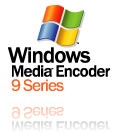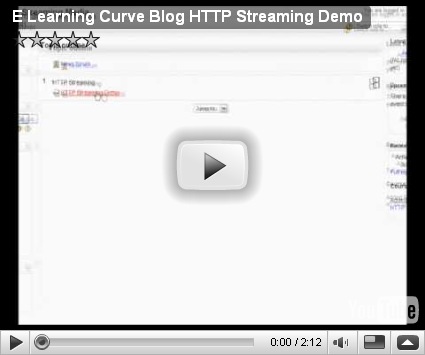Deploying streaming media content with the web server approach is very similar to the download-and-play model I described in yesterday's post: it's a pull technology.
Using this paradigm, the initial request for data originates from the client, and then is responded to by the server. When using digital media, uncompressed audio and video is first compressed into a single, muxed (multiplexed) media file for delivery over the Internet  or a network at a specific bit rate. The media file is then placed on a regular web server. A web page containing the media file's URL is also created and placed on the same web server. When the link on the web page is clicked on, a client-side player (such a Windows Media Player or QuickTime Player) downloads and plays the requested media file.
or a network at a specific bit rate. The media file is then placed on a regular web server. A web page containing the media file's URL is also created and placed on the same web server. When the link on the web page is clicked on, a client-side player (such a Windows Media Player or QuickTime Player) downloads and plays the requested media file.
In the context of e-learning, it's pretty standard for a video demo (for example) to be stored and progressively streamed from a Moodle LMS running on an Apache such as Apache server (see Figure 1)
Figure 1. Demonstration: Uploading a WMV file to Moodle, and playback via HTTP streaming in Windows Media Player
[Click to play the demo]
From a user's perspective, this process looks and feels identical a download-and-play case use case. From a technical point of view, the difference lies in how the client functions.
Unlike the download-and-play model, the client player starts actually starts playing the streamed digital media file while it's being  downloaded. This is possible because the content is cached: a process of collecting the first part of a media file before playing. This small 'buffer' of information allows the content to continue playing even during periods of high network congestion. With this delivery method, the client retrieves data as fast as the Web server, network and client will allow, regardless of the quality of the
downloaded. This is possible because the content is cached: a process of collecting the first part of a media file before playing. This small 'buffer' of information allows the content to continue playing even during periods of high network congestion. With this delivery method, the client retrieves data as fast as the Web server, network and client will allow, regardless of the quality of the  compressed stream. Only certain media file formats support this type of progressive playback including Microsoft's Windows Media format (WMV) and Apple's QuickTime (MOV).
compressed stream. Only certain media file formats support this type of progressive playback including Microsoft's Windows Media format (WMV) and Apple's QuickTime (MOV).
Web server streaming uses the Hyper Text Transport Protocol (HTTP), the standard Web protocol used by all Web servers and Web browsers for communication between the server and the client. HTTP operates on top of the Transmission Control Protocol (TCP), which handles all the data transfers.
It's useful to remember that HTTP/TCP is optimized for asynchronous, static applications, such as displaying static Web pages, and file transfer; this can affect the distribution and delivery of motion-based, asynchronous ('on-demand') content. Users may experience interruptions, 'glitches,' and temporary loss of playback because to the limitations of the HTTP and TCP protocols when handling multimedia content.
More...
--






1 comment:
Interesting post. A more usable way to deliver video online is to convert the wmv, mov, avi files to flash video (flv or mp4) so that they can be played within the browser window like a YouTube video.
This removes the reliance of the client having either Quicktime or Windows Media player installed and is therefore compatible with over 98% of internet users.
In my opinion Moodle and many other learning management systems are falling behind in terms of seamless video delivery.
There are alternative learning management systems available now that are more multimedia inclinded. A system like Litmos Online Training will automatically do the video conversion to Flash video format and provide a YouTube like experience for the user only in a private and trackable way.
Post a Comment